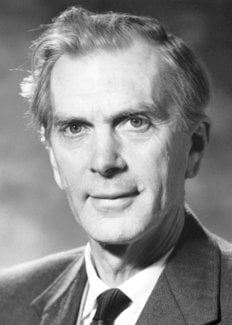Martin Ryle
Biographical

I was born on September 27, 1918, the second of five children. My father John A. Ryle was a doctor who, after the war, was appointed to the first Chair of Social Medicine at Oxford University.
I was educated at Bradfield College and Oxford, where I graduated in 1939. During the war years I worked on the development of radar and other radio systems for the R.A.F. and, though gaining much in engineering experience and in understanding people, rapidly forgot most of the physics I had learned.
In 1945 J.A. Ratcliffe, who had been leading the ionospheric work in the Cavendish Laboratory, Cambridge before the war, suggested that I apply for a fellowship to join his group to start an investigation of the radio emission from the Sun, which had recently been discovered accidentally with radar equipment.
During these early months, and for many years afterwards both Ratcliffe and Sir Lawrence Bragg, then Cavendish Professor, gave enormous support and encouragement to me. Bragg’s own work on X-ray crystallography involved techniques very similar to those we were developing for “aperture synthesis”, and he always showed a delighted interest in the way our work progressed.
In 1948 I was appointed to a Lectureship in Physics and in 1949 elected to a Fellowship at Trinity College. At this time Tony Hewish joined me, and in fact four other members of our present team started their research during the period 1948-52.
In 1959 the University recognized our work by appointing me to a new Chair of Radio Astronomy.
During 1964-7 I was president of Commission 40 of the International Astronomical Union, and in 1972 was appointed Astronomer Royal.
In 1947 I married Rowena Palmer, and we have two daughters, Alison and Claire, and a son, John. We enjoy sailing small boats, two of which I have designed and built myself.
| Awards |
| 1952 Fellow of Royal Society of London |
| 1954 Hughes Medal, Royal Society of London |
| 1955 Halley Lecturer, University of Oxford |
| 1958 Bakerian Lecturer, Royal Society of London |
| 1963 Van der Pol Medal, U.R.S.I. |
| 1964 Gold Medal, Royal Astronomical Society, London |
| 1965 Henry Draper Medal, U.S. National Academy of Sciences; Holweck Prize, Societé Française de Physique |
| 1968 Elected Foreign Member of the Royal Danish Academy of Sciences and Letters |
| 1970 Elected Foreign Honorary Member of American Academy of Arts and Sciences |
| 1971 Elected Foreign Member of U.S.S.R. Academy of Sciences. Morris N. Liebmann Award; Institution of Electrical & Electronic Engineers. Faraday Medal, Institution of Electrical Engineers. Popov Medal, USSR Academy of Sciences. Michelson Medal, Franklin Institute, U.S.A |
| 1973 Royal Medal, Royal Society of London |
|
1974 Bruce Medal, Astronomical Society of the Pacific. Foreign Member, Deutsche Akademie der Naturforscher, Leopoldina. Honorary D.Sc. of the Universities of Strathclyde (1968), Oxford (1969) and Nicholas Copernicus University of Torun (1973). |
This autobiography/biography was written at the time of the award and later published in the book series Les Prix Nobel/ Nobel Lectures/The Nobel Prizes. The information is sometimes updated with an addendum submitted by the Laureate.
Sir Martin Ryle died on October 14, 1984.
Nobel Prizes and laureates
See them all presented here.
